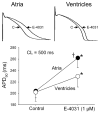Atrial-selective effects of chronic amiodarone in the management of atrial fibrillation
- PMID: 19084813
- PMCID: PMC2640450
- DOI: 10.1016/j.hrthm.2008.09.015
Atrial-selective effects of chronic amiodarone in the management of atrial fibrillation
Abstract
Background: Although amiodarone is one of the most effective pharmacologic agents used in clinical management of atrial fibrillation (AF), little is known about its differential effects in atrial and ventricular myocardium.
Objectives: This study sought to compare the electrophysiological effects of chronic amiodarone in atria and ventricles.
Methods: We compared the electrophysiological characteristics of coronary-perfused atrial and ventricular wedge preparations isolated from untreated and chronic amiodarone-treated dogs (amiodarone, 40 mg/kg/day for 6 weeks, n = 12).
Results: Chronic amiodarone prolonged action potential duration (APD(90)) predominantly in atria compared to ventricles and prolonged the effective refractory period (ERP) more than APD(90) in both ventricular and atrial preparations (particularly in the latter) due to the development of postrepolarization refractoriness. Amiodarone reduced dispersion of APD(90) in both atria and ventricles. Although the maximum rate of increase of the action potential upstroke (V(max)) was significantly lower in both atria and ventricles of amiodarone-treated hearts versus untreated controls, the reduction of V(max) was much more pronounced in atria. Amiodarone prolonged P-wave duration more significantly than QRS duration, reflecting greater slowing of conduction in atria versus ventricles. These atrioventricular distinctions were significantly accentuated at faster activation rates. Persistent acetylcholine-mediated AF could be induced in only 1 of 6 atria from amiodarone-treated versus 10 of 10 untreated dogs.
Conclusion: Our results indicate that under the conditions studied, chronic amiodarone has potent atrial-predominant effects to depress sodium channel-mediated parameters and that this action of the drug is greatly potentiated by its ability to prolong APD predominantly in the atria, thus contributing to its effectiveness to suppress AF.
Figures






Comment in
-
Does the postrepolarization refractoriness play a role in amiodarone's antiarrhythmic efficacy?Heart Rhythm. 2008 Dec;5(12):1743-4. doi: 10.1016/j.hrthm.2008.09.032. Epub 2008 Oct 1. Heart Rhythm. 2008. PMID: 19084814 No abstract available.
References
-
- Nattel S, Carlsson L. Innovative approaches to anti-arrhythmic drug therapy. Nat Rev Drug Discov. 2006;5:1034–49. - PubMed
-
- Singh BN. Amiodarone: a multifaceted antiarrhythmic drug. Curr Cardiol Rep. 2006;8:349–55. - PubMed
-
- Kodama I, Kamiya K, Toyama J. Amiodarone: ionic and cellular mechanisms of action of the most promising class III agent. Am J Cardiol. 1999;84:20R–8R. - PubMed
-
- Goldschlager N, Epstein AE, Naccarelli GV, et al. A practical guide for clinicians who treat patients with amiodarone: 2007. Heart Rhythm. 2007;4:1250–9. - PubMed
Publication types
MeSH terms
Substances
Grants and funding
LinkOut - more resources
Full Text Sources
Other Literature Sources
Medical

